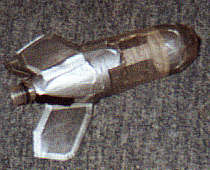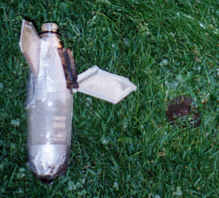|
Lift off 1 litre
Power Rocket
These are
photographs taken of the rocket. It has been around a
while and has had numersous launches - hence the quantity
of tape on it.
 |
This is it on the carpet at
home. You can see the construction and there is
a tape up the side that has lines on it to make
measurements in the field easier. The nose is
covered with pennies and then tape to make it
smoother.
The rear third is a reasonably smooth taper
which gives the rocket a good coefficient of drag.
When this one goes up, it is nothing more than
just a small dot very quickly.
|
 |
Once it hit the soft playing
field, it burried the nose and the decelleration
was so great that for the first time, one of the
fins came almost all fo the way off. Using taped
down tabs to keep the fins in place makes them
very resilient and they can withstand the
acceleration of launch where the rocket
acclerates over a few feet but on hitting the
ground, this one only had 3½ inches of soil to
stop it. Normally, it bounces but this time, it
just stopped.
|
 |
As you can see, the ground was
quite soft and the hole was perfectly shaped. A
bit of tape and the fin was back in place ready
for the next launch.
|

Click
here to hear a sound file of a launch of this rocket [Real Media].
The Fourier Transform (spectrum analysis) on the left is a plot of amplitude (colour) against frequency
(vertical axis) and time (horizontal axis). As you play the sound file, you will be able to
hear the parts as you see them.
The spectrum analysis was performed using Wave Tracer Version 3.2
5 - Five
4 - Four
3 - Three
2 - Two
1 - One
0 - Blastoff
R - Release
W - Water hitting the grass
I - Impact. Quite a thud for saying that this was around 20
metres away from the recorder which was on the ground.
|
 Back to the Rocket Design Back to the Rocket Design
 Back to the Water Rocket Index Back to the Water Rocket Index
|
|